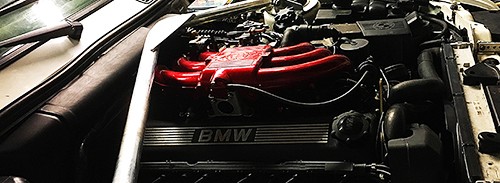Fixed..
Coolant bleeding
Collapse
X
-
The fan clutch could be bad, the thermostat could be bad, the radiator partially plugged or the water pump could have a bad impeller. At this age, every last part of the cooling system is way, way, overdue for replacement.The car makes it possible, but the driver makes it happen.
Jim Levie, Huntsville, AL -
they usually keep spinning but don't actually pull any real quantity of air. So it gets hot when stationary (or low speeds) until airflow through the radiator as you are driving is enough to overcome the effects of the fan.
It's normal to transfer from the radiator to the reservoir, especially when you stop as the coolant is no longer circulating so the temps continue to build until enough heat is naturally dissipated and it begins to cool down. Air in the system will also cause water to dump out into the reservoir. Is it past the full line when cold? if it's overfilled, when it's hot it'll push some out the drain hose too. How much are we talking, a bit of a dribble or a big puddle?Just a little project im working on
- http://www.lse30.com -Comment
-
Why are you bleeding the system in the first place? Was the head off?Comment
-
Air in the cooling system can do this. A bubble collects at the water pump, reducing it's ability to move coolant. Raising the engine speed breaks up and disburses to air. It could be that your bleed procedure is flawed. Do it by:
1) Using ramps or a jack get the front of the car 1' or more higher than
the rear. That will make the radiator and bleed screw the highest point
on the engine and facilitate removal of air.
2) With the bleed screw open, add coolant until no more air comes out of
the bleed.
3) Leave the filler cap off, or at least loose, and set the heat for max
temp and fan speed. Leaving the cap loose will prevent air that's still
in the system from causing a "coolant fountain" once the engine heats
up. Start the engine and allow it to warm up to operating temp. As it
warms up occasionally crack the bleed screw to release any air and top
up the coolant as necessary.
4) Once the engine is at temp bring it up to 2000-2500rpm for a few seconds
several times. Then crack the bleed until no more air is released. At
this point the heater should be throwing lots of hot air, which
indicates that the heater core is filled with coolant. You may have to
repeat this a few times to get all the air out.
5) Drive the car a bit, allow it to cool back down, and recheck the
bleed for air. Over the next few days you may get very small amounts (a
few bubbles) of air out of the bleed screw.The car makes it possible, but the driver makes it happen.
Jim Levie, Huntsville, ALComment


Comment